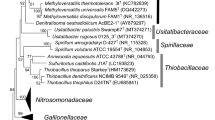Abstract
Two new species of heliobacteria isolated from cyanobacterial mats of two alkaline sulfidic hot springs are formally described. Strains BR4 and BG29 are assigned to anoxygenic phototrophic bacteria of the familyHeliobacteriaceae, since they possess the unique properties of this taxon: strict anaerobiosis, formation of bacteriochlorophyllg, the lack of extensive intracytoplasmic membranes and chlorosomes, an unusual cell wall structure, and phylogenetic relatedness to the low G+C gram-positive eubacteria. Based on the 16S rDNA sequence similarity, strains BR4 and BG29 are assigned to the genusHeliobacterium and described as two new species of this genus:Heliobacterium sulfidophilum sp. nov. andHeliobacterium undosum sp. nov. The G+C content of the DNA is 51.3 mol % inHbt. sulfidophilum and 57.2-57.7 mol % inHbt. undosum. The cells ofHbt. sulfidophilum are rods, and the cells ofHbt. undosum are slightly twisted spirilla or short rods. Both new bacteria are motile by peritrichous flagella.Hbt. sulfidophilum produces endospores. The new bacteria are strict anaerobes growing photoheterotrophically on a limited range of organic compounds. In the dark, they can switch from photosynthesis to the slow fermentation of pyruvate. Biotin is required as a growth factor. Both species are highly tolerant to sulfide (up to 2 mM at pH 7.5) and oxidize it photoheterotrophically to elemental sulfur; photoautotrophic growth was not observed. The temperature optimal for growth ofHbt. sulfidophilum andHbt undosum is 30–35‡C, and the optimal pH is 7–8.
Similar content being viewed by others
References
Madigan, M.T. and Ormerod, J.G., Taxonomy, Physiology, and Ecology of Heliobacteria,Anoxygenic Photosynthetic Bacteria, Blankenship, R.E., Madigan, M.T., and Bauer, C.E., Eds., Dordrecht: Kluwer, 1995, pp. 17–30.
Woese, C.R., Debrunner-Vossbrinck, B.A., Oyaizu, H., Stackebrandt, E., and Ludwig, W., Gram-Positive Bacteria: Possible Photosynthetic Ancestry,Science, 1985, vol. 229, pp. 762–765.
Starynin, D.A. and Gorlenko, V.M., Sulfide-oxidizing] Spore-forming Heliobacteria Isolated from a Hot Sulfide Spring,Mikwbiologiya, 1993, vol. 62, no. 3, pp. 556–563.
Starynin, D.A., Lysenko, A.M., and Gorlenko, V.M., Taxonomic Position of Heliobacteria Studied by DNA-] DNA Hybridization,Abstracts of the VIII Int. Symp. on Phototrophic Pwkaryotes (September 10–15, 1994,Urbino, Italy), 1994, p. 97.
Kimble, L.K., Mandelco, L., Woese, C.R., and Madigan, M.T.,Heliobacterium modesticaldum, sp. nov., a Thermophilic Heliobacterium of Hot Springs and Volcanic Soils,Arch. Microbiol, 1995, vol. 163, pp. 259–267.
Bryantseva, LA., Gorlenko, V.M., Kompantseva, E.I., Achenbach, L.A., and Madigan, M.T.,Heliorestis daurensis, gen. nov., sp. nov., an Alkaliphilic Rod-to-Coiledshaped Phototrophic Heliobacterium from a Siberian SodaLake, Arch. Microbiol, 1999, vol. 172, pp. 167–174.
Bryantseva, I.A., Gorlenko, V.M., Kompantseva, E.I., Tourova, T.P., Kuznetsov, B.B., and Osipov, G.A., Alkaliphilic HeliobacteriumHeliorestis baculata sp. nov. and Emended Description of the GenusHeliorestis, Arch. Microbiol. (in press).
Pfennig, N. and Lippert, K.D.,Uber das Vitamin B12-Bidurfnis phototropher Schwefelbakterien,Arch. Mikrobiol, 1966, vol. 55, pp. 245–256.
Reznikov, A.A., Mulikovskaya, E.P., and Sokolov, I.Yu.,Metody analiza prirodnykh vod (Methods for the Analysis of Natural Waters), Moscow: Nedra, 1970, p. 118.
Triiper, H.G. and Schlegel, H.G., Sulphur Metabolism inThiorhodaceae: 1. Quantitative Measurements of Growing Cells ofChromatium okenii, Antonie van Leeuwenhoek, 1964, vol. 30, pp. 225–238.
Laemmli, U.K., Cleavage of Structural Proteins during the Assembly of the Head of Bacteriophage T4,Nature, 1970, vol. 227, pp. 680–685.
Dice, L.R., Measurement of the Amount of Ecologic Association between Species,Ecology, 1945, vol. 26, pp. 297–302.
Marmur, J.A., Procedure for the Isolation of Deoxyribonucleic Acid from Microorganisms,J. Mol. Biol., 1961, vol. 3, pp. 208–218.
Owen, R.J., Hill, L.R., and Lapage, S.P., Determination of DNA Base Composition from Melting Profiles in Dilute Buffers,Biopolymers, 1961, vol. 7, pp. 503–516.
De Lay, J., Cattoir, H., and Reynaerts, A., The Quantitative Measurement of DNA-DNA Hybridization from Renaturation Rates,Eur. J. Biochem., 1970, vol. 12, pp. 133–142.
Zhilina, T.N., Tourova, T.P., Kuznetsov, B.B., Kostrikina, N.A., and Lysenko, A.M.,Orenia sivashensis sp. nov., a New Moderately Halophilic Anaerobic Bacterium from Lake Sivash Lagoons,Mikwbiologiya, 1999, vol. 68, no. 4, pp. 519–527.
Van de Peer, Y. and De Wachter, R., TREECON for Windows: A Software Package for the Construction and Drawing of Evolutionary Trees for the Microsoft Windows Environment,Comput. Appl. Biosci., 1994, vol. 10, pp. 569–570.
Taikaichi, S., Inoue, K., Akaike, M., Kobayashi, M., Oh-Oka, H., and Madigan, M.T., The Major Carotenoid in All Species of Heliobacteria is the C30 Carotenoid 4,4’-Diaponeurosporene, Not Neurosporene,Arch. Microbiol, 1997, vol. 168, pp. 277–281.
Beer-Romero, P., Favinger, J.L., and Gest, H., Distinctive Properties of Bacilliform Photosynthetic Heliobacteria,FEMS Microbiol. Lett., 1988, vol. 49, pp. 451–454.
Aase, B., Jantzen, E., Bryn, K., and Ormerod, J., Lipids of Heliobacteria Are Characterised by a High Proportion of Monoenoic Fatty Acids with Variable Double Bond Positions,Photosynthesis Res., 1994, vol. 41, pp. 67–74.
Author information
Authors and Affiliations
Corresponding author
Rights and permissions
About this article
Cite this article
Bryantseva, I.A., Gorlenko, V.M., Tourova, T.P. et al. Heliobacterium sulfidophilum sp. nov. andHeliobacterium undosum sp. nov.: Sulfideoxidizing heliobacteria from thermal sulfidic springs. Microbiology 69, 325–334 (2000). https://doi.org/10.1007/BF02756742
Received:
Issue Date:
DOI: https://doi.org/10.1007/BF02756742




